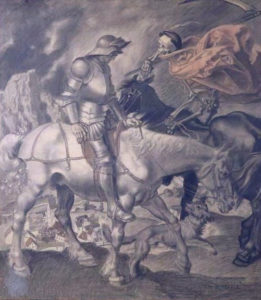 |
| Cropped image from the LotFP store |
I recently ran a FLAILSNAILS Carcosa one-shot on G+. This was a rescue mission for a character that had been imprisoned by the Donjon card from The Deck of Many Things.
Here are six Carcosan wilderness encounters that I developed for that adventure.
- T-rex corpse, skin mottled red and orange, being feasted upon by fist-sized maggots. Top of skull has been removed with surgical precision, and brain is missing.
- Bipedal humanoid robot (HD 8, AC 3), with a spear and a head that has a single, spotlight eye in the center of a cylinder head. It is dragging a dead velociraptor behind it. It has learned how to hunt by spying on humans, but doesn’t understand what to do with the dead animals, so it just drags them back to a cave.
- Cuddly fluff balls (2d6, 1 HP each, AC 7). Bright red, hovering, bobbing up and down gently. Look and behave exactly like poison dirigible fruit (see below), but if observed for a turn there is a 3 in 6 chance of seeing the fluff ball lazily open one or both of its eyes. If petted, a fluff ball will orbit the character. Orbiting fluff balls will give characters a save versus wands to avoid a normal missile (something like an arrow or bullet) that would otherwise hit. A success means that the CFB intercepts the missile and is destroyed.
- Poison dirigible fruit (2d6, 1 HP each, AC 7). Visually identical to cuddly fluff balls (see above), but if touched in any way will explode in a burst of poison glop (all within melee range save or die). A poison dirigible fruit tree will grow in the corpse of any characters so slain, and will produce 2d6 dirigible fruit in 1d6 days.
- Mummy with lower half of body buried (HD 5, AC 5, eyes shoot 2 lasers, save versus death ray or take 5 dice of damage). Wearing an emerald medallion (2000 GP). Quiescent unless the emerald medallion is disturbed. Two dead orange men nearby, one with a scorched hole blown in his head, the other with a scorched hole blown in his chest. 1d6 primitively armed orange men huddled at a safe distance discussing how to relieve the mummy of the medallion. They are not interested in treasure other than gems and technology, but will serve if offered such incentives.
- Floating circular platform, hovers 15′ above the ground. Space alien technology. 1 in 6 chance to figure out how to operate (intelligence modifier applies, only one try per character though). Can be moved at a rate of 10′ per turn. 3 bone men with spears have built a hut on top, and “desert fishing lines” hang down. The bone men are extremely xenophobic (reaction roll penalty of 2). One of the bone men has 2 sleep gas grenades (as sleep spell but a save versus paralysis applies, 30′ blast radius).





